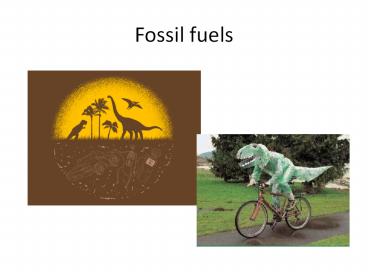Fossil fuels - PowerPoint PPT Presentation
Title:
Fossil fuels
Description:
Fossil fuels FOSSIL FUELS Carbon or hydrocarbons (a compound made of hydrogen and carbon) found in the earth s crust Formed from the bacterial decay of plant and ... – PowerPoint PPT presentation
Number of Views:361
Avg rating:3.0/5.0
Title: Fossil fuels
1
Fossil fuels
2
FOSSIL FUELS
- Carbon or hydrocarbons (a compound made of
hydrogen and carbon) found in the earths crust - Formed from the bacterial decay of plant and
animal life in ancient (a few hundred million
years ago) seas. - The decomposing material was covered with mud and
sediment - This increased the pressure and temperature on
the material and deprived it of oxygen. - A variety of hydrocarbon molecules are created in
solid, liquid and gas states. - The gas and liquid could travel through the
porous rock and collect in geological traps (rock
features that prevent further movement of the
hydrocarbons).
3
Petroleum traps
4
Why is there oil in Texas?
5
A little history.
- 1859 Colonel Drake first drilled for oil and
found it in Titusville, PA. - Previous to this, the only oil known were surface
springs. - Other wells were drilled and the oil was refined
into kerosene. - Oil was soon found in Ohio, Indiana, California
and Texas.
6
What about Kentucky or Tennessee?
7
Oil in KY
- Well that didnt really happen but there are oil
fields in KY and TN! - Largest in KY is Big Sinking, spanning Estille,
Lee, Powell and Wolfe counties.
8
Current KY oil reserves
9
US Oil Reserves
10
All good things must come to and end..
- It looks like there is a lot left, but it wont
last very long. - It takes about 11 years from the time an oil
reserve is discovered until the oil reaches
production. - Also, the production of any energy resource has
to be economically feasible it cant take more
energy to get the energy produced than the energy
itself produces. - Q8 denotes the amount of a resource available for
all time, until it is exhausted
11
M.K. Hubbart The Nostradomus of petroleum
- Predicted Q8 to be 165 X 109 barrels of oil for
the US in 1956, (this did not include Alaska). - Much smaller value than his contemporaries and he
predicted that US oil production would peak
between 1966 and 1971 and then fall off,
independent of anything the oil industry did. - Not a popular prediction, but it rang true, US
oil production peaked in 1970.
12
Hubbart Curve
13
Oil production around the world
14
World Oil Production
15
Petroleum From the ground to your gas tank
- What comes out of the ground is not immediately
useful - It has to be treated, or refined, to produce
useful fuels - First step is fractional distillation
- This process separates the various petroleum
based products.
16
Fractional Distillation
- The petroleum is heated to about 400 C which
vaporizes it. - The vapors are sent into a tower called a
fractionating column. As they rise and cool
different fuel products condense at different
heights.
17
Further treatments
- What comes out of the distillation process is not
quite ready for use yet. It still needs to be
modified. - For example Gasoline needs octane added and tar
needs heavy molecules removed from it.
18
Treatment processes
- Thermal cracking The product is exposed to high
temperatures and pressures which break heavy
molecules into lighter ones. - Catalytic conversion petroleum vapor is passed
over a alumina-silicate mixture or clay which
creates a chemical reaction and adds octane to
the gas - Polymerization light hydrocarbon molecules are
joined and they produce heavier molecules.
Natural gas is made into high octane fuels this
way.
19
Alkane Hydrocarbons
- You have heard these names before methane,
ethane, propane, butane, pentane, hexne, heptane,
octane. - Methane and ethane are the main components of
natural gas - Propane and butane can be liquefied at fairly low
pressures, and are well known as liquefied
petroleum gas (LPG) - Pentane, nexane, heptane and octane are
volatile liquids. They are used as fuels in
internal combustion engines, as they vaporize
easily on entry into the combustion chamber
without forming droplets, which would impair the
uniformity of the combustion.
- Methane
- Carbon atom is black, H atom
- is white
- Ethane
20
How long?
- Good site to look at is http//www.physics.emich.e
du/ebehringer/FossilFuels/oil_simple.html
21
Natural gas
- Used since the 6th century BCE in China and
Japan. They used bamboo pipes to carry it to
lights. - For the most part, it was considered an annoying
by product of petroleum exploration and was often
burned off of oil wells. - 1821 Fredonia, New York. A pipe provided NG to 30
burners - Development was slow due to the lack of pipeline
infrastructure - During and after WWII, its use became more
widespread because it was inexpensive and
pipelines were laid across the country.
22
Uses
- Power plants gas turbines have a higher
efficiency in converting the fuel to power than
steam turbines (we will talk about these turbines
later) . Plants are cheaper to build and more
environmentally friendly. - Transportation Use is growing, but limited by
range (need to store the fuel in the vehicle
under high pressure and there is not a widespread
distribution system).































